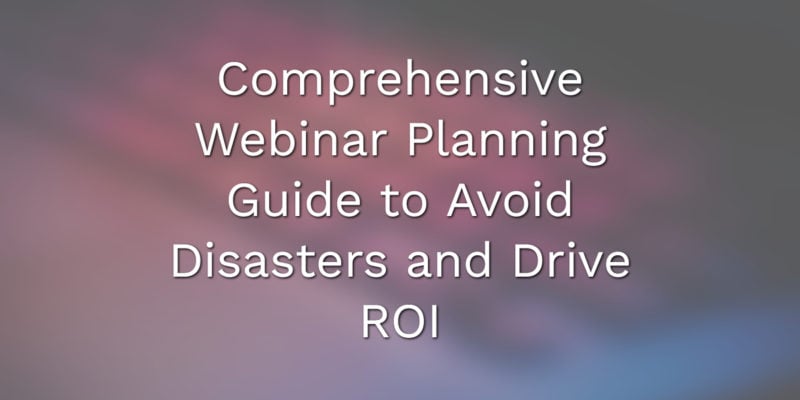Your webinar starts in 10 minutes. You’ve got 147 people registered. You click “Start Broadcast” and realize your screen-share feature isn’t working. Your hands start sweating. Your co-presenter messages you frantically. Attendees start to leave.
Or maybe you’ve experienced the other nightmare: you spend three weeks on a webinar, send dozens of promotional emails, and watch only 23 people show up out of 300 registrations. You deliver your presentation to a nearly empty virtual room and wonder where you went wrong.
These scenarios happen more often than anyone wants to admit. The webinar space has become increasingly sophisticated, and the gap between successful programs and disappointing ones keeps widening.
The webinar market is projected to reach $4.44 billion in 2025. Companies that plan their webinars strategically see meaningful conversion rates and measurable ROI. The difference comes down to systematic planning that addresses everything from optimal time slots to follow-up email sequences that actually get opened.
This guide walks you through the complete webinar planning process, backed by industry research and real performance data.
What Webinar Planning Actually Means

Webinar planning extends far beyond blocking calendar time and creating a PowerPoint deck. Think of planning a webinar like organizing a dinner party for 200 people you’ve never met, in their homes, where you can’t see if they’re enjoying themselves or scrolling through Instagram. You need to anticipate every possible thing that could go wrong, keep everyone engaged despite the distance, and leave them wanting more.
The planning process breaks down into eight distinct phases. Skip any one of them and you compromise your results.
Strategic planning starts 6-8 weeks before your event (longer for complex productions). You define objectives that matter. “Get leads” fails as an objective because it lacks specificity. “Acquire 200 qualified enterprise leads with 40% meeting our sales qualification threshold” provides a measurable target you can plan around.
Content development involves creating materials that deliver genuine value before asking for anything in return. The most successful webinars focus heavily on education and insights rather than constant promotion. Most presenters flip this ratio and wonder why attendees leave early.
Technical preparation means testing everything twice. Your microphone, your internet connection, your backup internet connection, your screen-share feature, your polling functionality. Technical issues remain among the most common preventable reasons webinars fail. Proper testing eliminates most of them.
Promotion strategy determines whether anyone shows up. You could create the most brilliant content ever, but seven registrants means you’ve wasted your time. Email marketing consistently performs as the top channel for driving webinar registrations. Your email sequence matters more than your Instagram posts.
Execution protocol keeps you calm when things inevitably go sideways during the live event. Have a crisis management plan. This demonstrates professionalism rather than pessimism.
Follow-up systems convert interested attendees into actual customers. Approximately 45-47% of webinar engagement now happens through on-demand viewing. Your follow-up needs to account for both live attendees and replay watchers.
Analytics review tells you what worked and what didn’t. Without measurement, you’re guessing about improvements.
Optimization cycles compound your advantages over time. Each webinar should perform better than the last because you’re learning and adapting.
The common denominator among failed webinars? People treat planning as an optional nice-to-have rather than the foundation of success. They wing it. The results show.
When to Actually Host Your Webinar (Because Timing Is Everything)

You probably picked Tuesday at 2 PM because that slot was free on your calendar. Most people do. Here’s what the data actually says about webinar timing, based on analysis of over 500,000 webinar registrants.
Wednesday consistently performs as the best day for webinar attendance. Thursday and Tuesday follow closely behind. The second half of the week (Tuesday through Thursday) accounts for the majority of successful webinars because attendees have settled into their work rhythm but haven’t mentally checked out for the weekend.
Mondays feel too frantic for most people. Fridays feel too close to freedom. Wednesday hits the sweet spot where people are present and engaged.
Mid-day slots (specifically 11 AM and 2 PM in your target audience’s time zone) consistently show 6-10% higher attendance rates than early morning or late afternoon options. These improvements matter significantly in a world where average attendance rates hover around 35-45%.
For companies with audiences spanning multiple U.S. time zones, 11 AM Pacific/2 PM Eastern represents the golden hour. West Coast folks have finished their morning meetings. East Coast people have wrapped up lunch. Everyone can attend.
Global audiences present an impossible challenge. You cannot accommodate Europe and Asia-Pacific simultaneously. Physics won’t cooperate. You have two choices: host multiple sessions at different times, or accept that one region will watch the replay and make that on-demand experience exceptional.
January webinars tend to see strong engagement as professionals pursue learning goals at the start of the year. Conversely, many B2B marketers report that summer months (July and August specifically) can be challenging due to vacation schedules and general summer slowness.
60-minute webinars tend to attract significantly more registrants than 30-minute sessions. According to research, approximately 2.1 times more registrants choose the longer format. This defies assumptions about shrinking attention spans, but longer sessions signal substantial value and self-select genuinely interested attendees.
A substantial portion of registrations occurs in the final week before the event, with many people even registering on the day itself. You cannot stop promotion a week out and hope for the best. You need consistent promotion right up until you go live.
Industry context matters. Technology companies may see different optimal timing than healthcare or education sectors. B2B audiences generally need mid-week business hours, while B2C events can succeed evenings and weekends when consumers control their schedules.
Stop guessing about timing. Start testing to see what works best for your specific audience.
Choose Where to Host Your Webinar (Platform Selection Demystified)

The webinar platform space changed dramatically in 2024-2025. The options can feel overwhelming. Should you choose Zoom because everyone knows it? Try Livestorm because the browser-based approach eliminates downloads? Invest in ON24 because enterprise companies use it?
Walk through this decision systematically. The wrong platform resembles buying a sports car when you needed a pickup truck. The platform might impress people, but it won’t do what you actually need.
Enterprise Platforms for Scale
Zoom Events, Webex, and ON24 handle massive scale. These platforms accommodate up to 100,000 attendees. Zoom now offers AI Companion features including real-time translation in multiple languages and automated content assistance. ON24 dominates the B2B demand generation space with sophisticated lead scoring and immersive branded experiences.
These platforms make sense when you’re running large-scale events, need enterprise-grade security and compliance, require extensive integration with your marketing stack, or want white-glove support. They’re expensive. Custom pricing typically starts in the thousands per month.
Mid-Market Platforms for Balance
Mid-market platforms balance capability with accessibility. Livestorm pioneered browser-based delivery, which means attendees don’t download anything. They click a link and join immediately. The AI-powered features help with content repurposing and automatically generate assets from your recordings.
Demio emphasizes simplicity with quick setup times and unlimited webinars on their plans. No arbitrary restrictions based on event count.
BigMarker provides extensive customization including white-labeling and automation timelines. You can set polls to open automatically at specific timestamps, schedule waiting rooms to open precisely on time, and create professional experiences without manual button-clicking during the event.
These platforms typically range from $79-$299 per month and make sense for most businesses running regular webinar programs.
Specialized Platforms for Specific Needs
EWebinar exclusively handles automated pre-recorded webinars with on-demand sessions that can start shortly after registration. If you’re scaling customer onboarding or running evergreen training, this eliminates the need for live presence entirely.
Crowdcast enables simultaneous multi-platform streaming to Facebook, YouTube, Twitch, and LinkedIn via RTMP. One broadcast reaches multiple audiences.
WebinarNinja targets coaches and educators with built-in email marketing and competitive pricing starting around $24/month.
Seven Critical Evaluation Dimensions
Audience capacity matters both for current needs and future growth. Don’t paint yourself into a corner with a platform that maxes out at 100 attendees when you plan to scale.
Integration requirements can make or break your workflow. Does the platform sync with your CRM (Salesforce, HubSpot), email marketing tool (Mailchimp, ActiveCampaign), or marketing automation platform (Marketo, Pardot)? Native integrations work better than Zapier workarounds.
AI capabilities separate 2025 platforms from legacy solutions. Can it automatically generate transcripts? Help with content repurposing? These features used to be nice-to-have. They’re increasingly essential for efficiency.
Hybrid event support provides flexibility. If you might ever want in-person attendees alongside virtual ones, your platform needs to handle both seamlessly.
Mobile experience quality determines whether you’re excluding a significant portion of potential attendees. Test any platform on mobile before you commit.
Analytics depth ranges from basic (attendance numbers) to sophisticated (engagement scoring, drop-off analysis, behavioral triggers). The difference matters when you’re serious about optimization.
Total cost of ownership extends beyond the monthly subscription. Factor in overage charges when you exceed attendee limits, costs for add-ons like recording storage or advanced analytics, and the time required to learn the platform.
People constantly overlook recording quality and distribution. Some platforms compress recordings heavily and make them unwatchable on replay. Others provide studio-quality output. Since making webinars available on-demand can increase total engagement by approximately 69%, this matters significantly.
Start with a mid-market platform unless you have specific requirements that demand enterprise features. Most businesses overestimate what they need and pay for capabilities they’ll never use.
The Technical Setup That Prevents Disasters
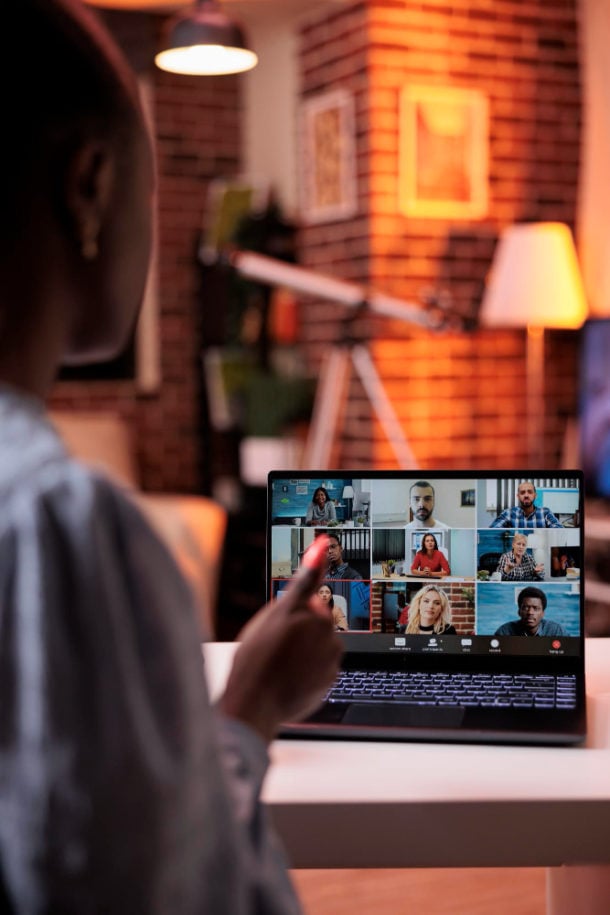
Technical issues remain among the most common preventable reasons webinars fail. You need to understand “The Triangle of Technical Difficulties” to prepare: power outages, internet disruptions, and software/hardware malfunctions.
Equipment That Actually Matters
That built-in laptop microphone and webcam broadcast “amateur hour” to your attendees. Professional external equipment stops being optional when you want people to take you seriously.
For audio, invest in a dedicated USB microphone ($100-300). The Blue Yeti, Audio-Technica ATR2100x, or Shure MV7 represent solid choices that dramatically improve sound quality. Pair it with headphones. Always use headphones during webinars to prevent the echo that happens when your microphone picks up audio from your speakers.
For video, an HD external webcam ($100-200) provides better quality than integrated laptop cameras. The Logitech C920, C922, or Razer Kiyo all work well. Position it at eye level so you’re looking into the camera, not down at it.
Lighting transforms video quality completely. A simple ring light ($30-100) eliminates the unflattering shadows that make you look like you’re hosting from a cave. Three-point lighting (key light, fill light, backlight) creates professional results, but even a single well-positioned light makes enormous difference.
Your Internet Connection as the Single Point of Failure
Minimum requirement: 5 Mbps upload speed. Recommended: 10+ Mbps. Test your speed at a reliable speed test site before every webinar.
Use a wired Ethernet connection instead of Wi-Fi. Wi-Fi offers convenience. Ethernet delivers reliability. Reliability matters more during live presentations. Run that cable.
Build Redundancy Into Every System
Even with perfect equipment and great internet, things can still go wrong. You need backup systems.
Backup internet source: Use your phone as a mobile hotspot. Test it beforehand. Know how to switch to it quickly if your primary connection fails.
Backup device: Keep a fully charged laptop or tablet ready to take over if your primary device crashes. Log into the webinar platform on both devices before you start.
Uninterruptible power supply (UPS): These battery backup devices ($100-300) keep your equipment running during power outages. They provide 15-30 minutes of backup power—enough to finish your presentation or gracefully reschedule.
Alternative audio: Know your platform’s phone dial-in number. If all else fails, you can call in while you troubleshoot video issues.
Printed notes: Keep physical copies of your slides and notes available. If your screen goes dark, you can continue to present from paper while technical support fixes the problem.
The Testing Protocol That Prevents Problems
According to comprehensive technical setup research, the most common technical failures trace back to four causes: insufficient bandwidth, poor audio setup, platform unfamiliarity, and lack of testing. All four are completely preventable.
Test twice: 24 hours before your webinar (full dress rehearsal with all technology), and 1 hour before (final verification that nothing changed overnight).
Test everything:
- Audio input and output
- Video quality and lighting
- Screen-share functionality
- Poll and interactive features
- Chat and Q&A systems
- Recording capability
- Bandwidth speed
- Platform features you’ll use
Professional presenters arrive in the virtual room 15 minutes early, not 2 minutes. This buffer allows for last-minute troubleshooting without panicking attendees.
Environment and Background Considerations
Find a quiet location where you won’t be interrupted. Put a “do not disturb” sign on your door. Silence your phone. Close unnecessary browser tabs and applications that consume bandwidth or might generate notification sounds.
Background matters. A cluttered or distracting background makes you look unprepared. Use a neutral background, blur it digitally, or set up a simple backdrop. Virtual backgrounds sometimes glitch and create a weird halo effect around your head. Test thoroughly if you plan to use them.
The goal of technical preparation delivers resilience rather than perfection. Things will occasionally go wrong despite your best efforts. The question becomes whether you have systems in place to recover gracefully or whether you’ll panic and lose your audience.
The 8-Week Planning Timeline (Your Roadmap to Success)
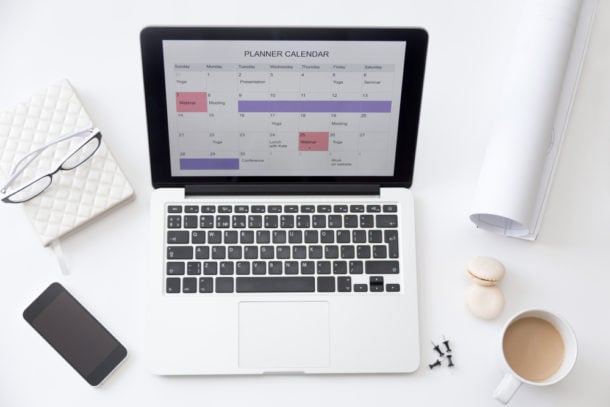
This 8-week timeline represents minimum viable preparation for professional webinars. Complex productions (flagship events, multiple speakers, elaborate content) need 12+ weeks. Adjust accordingly.
Weeks 8-6 Foundation Phase
This phase covers strategy before tactics. Most people skip this phase because nothing visible gets “done.”
Define your objectives with the SMART framework: Specific, Measurable, Achievable, Relevant, Time-bound. “Generate leads” fails this test because it lacks precision. “Acquire 200 qualified enterprise leads with 40% meeting our sales qualification threshold within 30 days of the webinar” passes because every word has meaning.
Your objective determines everything downstream. Lead generation webinars require registration gates and strong CTAs. Educational content builds authority but might not convert immediately. Product launches need demos and limited-time offers. Customer onboarding focuses on reducing support tickets and increasing product adoption.
Research your audience thoroughly. Don’t guess what they care about. Find out through:
- Pre-registration surveys that ask what topics interest them most
- Sales team consultation about common customer questions
- Website behavior analysis that shows which content resonates
- Social media listening for trending discussions
- Customer support ticket analysis that reveals pain points
Create detailed personas. Cover demographics (age, location, income), professional roles (job title, department, seniority), behavioral traits (learning style, content preferences), and current knowledge level about your topic.
Select your topic with five criteria: relevance to current audience needs, uniqueness offering perspective unavailable elsewhere, clarity through specificity rather than vagueness, tangible value providing actionable insights, and timeliness aligned with industry trends.
“5 Proven Marketing Strategies to Double Your Leads in 2025” outperforms “Marketing Strategies” because specificity signals value and sets clear expectations.
Choose your format: live, automated, hybrid, or series. Each serves different purposes. Live webinars enable real-time interaction and authentic connection but create time zone limitations. Automated pre-recorded sessions eliminate technical risk while they provide consistent quality. Hybrid combines pre-recorded content with live Q&A. Series webinars build sustained learning with higher attendee loyalty and are becoming increasingly popular.
Budget comprehensively. Costs cascade across platform fees ($50-500+/month), content creation, promotional spend, equipment, speaker fees, and staff time. Most organizations dramatically underestimate the all-in investment, then wonder why they’re resource-constrained.
Weeks 5-4 Development Phase
Now you create the actual content and promotional materials.
Develop content that prioritizes value delivery. The most successful webinars focus heavily on education and actionable insights rather than constant sales pitches. This approach builds trust and drives conversions through establishing your expertise first.
Structure your presentation with the proven narrative arc:
Introduction (5%): Welcome, speaker introduction, agenda preview, expectations setting
Main content (80%): Core teaching broken into digestible 8-12 minute segments
Conclusion (15%): Summary of key takeaways, clear call-to-action, Q&A session
Design slides for engagement, not as a transcript of your words. Slides support your presentation rather than replace it. Best practices include:
- Minimal text (5-7 words per bullet point maximum)
- One concept per slide
- High-quality images and graphics
- Consistent branding with company colors and fonts
- Charts and infographics for data presentation
- 16:9 aspect ratio (standard for most displays)
- Readable on mobile devices (yes, people watch webinars on phones)
Plan interactive elements during development, not as afterthoughts. Design polls that align with your content goals. Create quiz questions for engagement checkpoints. Prepare discussion prompts. Set up resource handouts. Schedule breaks for sessions exceeding 45 minutes.
Create your landing page as your conversion hub. Essential elements include:
- Compelling headline that promises specific benefit
- Clear value proposition answering “what’s in it for me?”
- Bullet points of key takeaways (3-5 maximum)
- Speaker bios establishing credibility
- Social proof through testimonials or registration counts
- Prominent CTA button
- Minimal form fields (name and email typically sufficient because every additional field decreases conversions)
- Mobile optimization
Write your email sequence. Email marketing consistently ranks as the top-performing channel for webinar registrations. Your emails matter tremendously:
- Initial announcement (2-3 weeks before)
- Value-building follow-ups (1-2 additional emails)
- Registration confirmation (immediately after signup)
- Reminder at 1 week out
- Reminder 3-5 days out
- Reminder 24 hours before
- Reminder 1 hour before
- Optional: 5-minute warning
Develop promotional graphics for social media (sized appropriately for each platform), paid advertising, blog posts, and partner collaborations.
Weeks 3-2 Refinement Phase
This phase transforms good presentations into great ones.
Conduct full dress rehearsals. You need minimum two complete run-throughs where you present start to finish. Time each section precisely. Practice transitions between speakers. Record rehearsals for review. Have team members join from different locations to simulate real conditions.
Webinar professionals emphasize that you cannot approach a webinar like any other meeting. The camera, the platform, the virtual nature all require specific preparation and practice that differs from in-person presentations.
Assign team roles clearly:
Host/Organizer: Manages overall flow, introduces speakers, keeps time
Presenter/Speaker: Delivers content
Moderator: Handles chat and Q&A, surfaces great questions
Technical Support: Troubleshoots issues, monitors connection quality
Test platform features exhaustively. Polls, screen share, breakout rooms, recording—everything you plan to use. Test from multiple devices and browsers. What works perfectly on Chrome desktop might fail on Safari mobile.
Intensify promotion. Many registrations occur in the final week before your event. Accelerate your efforts rather than ease up. Run multi-channel campaigns across email, social media (LinkedIn performs best for B2B), blog posts, paid advertising, partner cross-promotion, and community engagement.
Week 1 Through Day-Of Execution Phase
Final rehearsal incorporates all feedback from previous run-throughs. This should feel smooth and natural.
Registration assessment: Are numbers where you hoped? If registrations fall dramatically below expectations, you have three options: postpone and promote more aggressively, lower expectations about attendee count, or continue knowing you’re building an on-demand asset regardless of live attendance.
Day-of preparation begins 15-60 minutes early depending on complexity. Log into the virtual room 15 minutes early to greet early attendees. Play intro music or display a welcome slide. Verify technical elements one final time. Position water and notes within reach. Display agenda or countdown timer. Have backup plans ready.
During the webinar:
- Start promptly (respecting attendees’ time shows professionalism)
- Welcome attendees warmly
- Set expectations and outline what you’ll cover
- Introduce speakers with credibility-establishing backgrounds
- Maintain engagement through polls, questions, and varied pacing
- Monitor chat for questions and technical issues
- Stick to your planned timing (running over disrespects attendees’ calendars)
- End with strong, clear call-to-action
Have crisis protocols ready. What if your platform crashes? What if your speaker doesn’t show up? What if your internet dies? Planned responses prevent panic.
Post-Event Optimization Phase
This phase determines whether your webinar was an expense or an investment.
Within 24 hours, send segmented follow-up emails:
Attendees who finished: Thank you with recording link, key takeaways, slides, resources, and clear next-step CTA
Partial attendees: Highlights of what they missed with recording timestamp links
No-shows: “Sorry you missed it” with bullet summary and recording access
Review analytics:
- Registration rate (registrations divided by landing page visitors)
- Attendance rate (attendees divided by registrants, where 35-45% is typical)
- Engagement metrics (poll participation, questions asked, chat activity, average watch time)
- Conversion metrics (CTA completion, desired actions taken)
- Financial metrics (cost per registration, cost per lead, ROI)
Distribute the recording strategically. Research shows that a significant portion of webinar engagement happens on-demand, with many attendees preferring to watch replays rather than attend live. Making webinars available on-demand can substantially increase total engagement. Create a “webinar theater” on your website as a centralized hub for all content.
Repurpose content aggressively. Transform your single webinar into blog posts, social media clips (30-90 seconds for Instagram/LinkedIn/TikTok), quote graphics, infographics, podcast episodes, email course series, and downloadable resources.
AI-powered tools have enabled dramatic increases in content repurposing efficiency. Research shows a 2,903% increase in AI-generated video clips between 2023-2024. This demonstrates how technology can multiply your content ROI with minimal additional effort.
Nurture leads with sophisticated segmentation:
Hot leads (asked product questions, requested pricing, stayed entire presentation): Immediate sales team follow-up
Warm leads (good attendance and engagement but no buying signals): Marketing nurture with case studies and testimonials
Cold leads (minimal engagement, short attendance): Newsletter inclusion and future webinar invitations
Content Creation That Actually Engages (Not Just Informs)
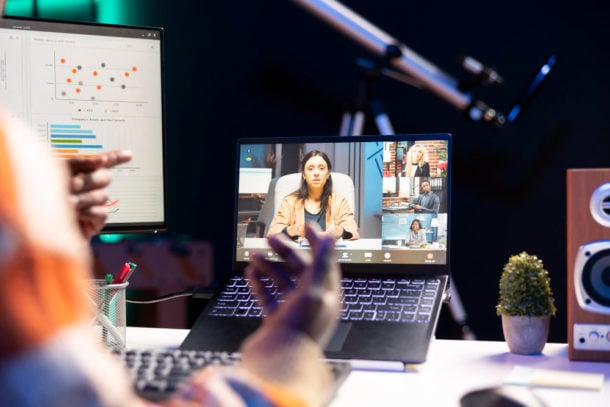
Most webinar content is boring. Soul-crushingly, “I’m-definitely-checking-email-right-now” boring.
The problem doesn’t stem from lack of information. Presenters actually overload audiences with too much content. The problem comes from lack of engagement strategy.
Start With Story, Not Statistics
Human brains are wired for narrative. Stories create emotional connections and improve information retention far better than facts alone. Yet most webinars open with “Today we’ll cover five strategies for…” and immediately lose half their audience.
Instead, open with a specific scenario your audience recognizes: “Three months ago, a client came to me frustrated because their webinars were getting great registration numbers but terrible attendance. Sound familiar?” Now you’ve created connection and curiosity.
Structure Content in Digestible Chunks
Attention spans during virtual presentations typically range 8-12 minutes before they wander. This doesn’t mean your webinar should be 8 minutes long. You need to create mental “chapter breaks” every 8-12 minutes.
Methods include transitioning to a different topic, inserting an interactive poll or question, changing your visual presentation style, or pausing for explicit summary and preview of what’s next.
Use the “3-30-3” Content Formula
Three big ideas, delivered in segments, with three specific action items per idea. This structure prevents overwhelming audiences while it ensures they leave with concrete next steps.
Apply the “So What?” Test to Every Slide
If you can’t articulate why your audience should care about the information on a specific slide, delete it. Ruthlessly cut anything that doesn’t directly serve your core objective.
Show, Don’t Just Tell
Demonstrate your software instead of describing it. Share your screen and walk through a real example instead of explaining the concept abstractly. Show before/after results. Use case studies with real names and numbers (with permission, obviously).
Design Slides That Support Rather Than Replace You
If attendees can get the same value from reading your slides, why did they bother to attend live? Slides should emphasize key points, provide visual interest, and display data that’s hard to describe verbally. They should never duplicate your entire script.
Incorporate Variety to Maintain Energy
Mix presentation formats: solo speaking, interview-style conversations, panel discussions, demo walkthrough, Q&A segments. Change camera angles if possible. Alternate between slides and on-camera presence. Visual variety maintains attention.
Plan Your Interactive Elements Strategically
Don’t just throw in a poll because you heard you should. Design polls that generate useful insights or create “aha” moments. Ask questions that reveal common misconceptions, then address them. Create quizzes that reinforce key learning. Pose discussion questions that spark chat conversation.
Master the Art of Pacing
Vary your speaking speed based on content complexity. Slow down for critical concepts that need to sink in. Speed up slightly during review or familiar territory. Pause strategically because silence creates anticipation and allows processing time.
Use Pattern Interrupts to Recapture Wandering Attention
Every 10-15 minutes, do something unexpected: ask a provocative question, share a surprising statistic, tell a brief story, show an unusual image, or change your presentation format. These jolts reset attention.
Create Knowledge Gaps That Curiosity Demands Filling
Humans hate incomplete information. Tease upcoming content: “In a few minutes, I’m going to show you the one mistake that’s probably costing you 30% of your potential registrations.” Now they have to stick around to find out.
End With Clarity and Urgency
Your conclusion should reinforce your 3 big ideas, provide clear next steps, create urgency for action (limited-time offer, bonus for quick action, deadline for access), and make the CTA frictionless.
The goal moves beyond creating content that checks boxes. You want to build an experience that leaves attendees thinking “I’m glad I invested this time” rather than “I could have read a blog post.”
Promotion Strategy That Fills the (Virtual) Room

You’ve created brilliant content. Your slides are gorgeous. Your technical setup is flawless. And 11 people registered.
This moment reveals that “if you build it, they will come” works in movies, not marketing.
Promotion makes or breaks your webinar, yet programs consistently underinvest time and resources here. Successful webinar programs allocate substantial resources to promotion, often spending as much time on promotion as creating content.
Start Promotion 2-3 Weeks Before Your Event
Earlier than that and people forget. Later and you miss significant registration opportunities.
Email Remains Your Primary Weapon
Email consistently ranks as the top-performing channel for webinar registrations and significantly outperforms other marketing channels. Email sequence strategy matters, not blasting your entire list once.
Your sequence should include:
Initial announcement email (2-3 weeks out) with compelling subject line (test multiple variations), clear value proposition, bullet points of what attendees will learn, speaker credibility markers, and prominent registration CTA.
Value-building emails (1-2 follow-ups) that share related content, address objections (“I’m too busy” becomes “This 45-minute investment will save you 10 hours weekly”), include social proof through testimonials, and highlight scarcity (“Only 100 spots available” or “Early bird pricing ends Friday”).
Reminder emails with escalating frequency: 1 week before, 3-5 days before, 24 hours before, 1 hour before. Each reminder should add new value. Don’t just repeat “Don’t forget!” Include sneak peeks of content, speaker interviews, or early questions from registrants.
Segment Your Emails
Send different messages to different groups rather than identical messages to everyone. Existing customers get different framing than prospects. People who attended previous webinars receive “based on what you learned last time” messaging. Industry-specific segments see relevant examples.
Social Media Amplifies Reach
Social rarely drives primary registrations. Use it to build awareness and reinforce your email messages. LinkedIn performs best for B2B content. Twitter works for tech and media audiences. Facebook depends on your demographic. Instagram requires strong visual assets.
Post frequency should increase as the event approaches: 3 weeks out (2-3 posts), 2 weeks out (3-4 posts), 1 week out (5-7 posts), final week (daily posts), day of (multiple reminder posts).
Paid Advertising Accelerates Results When You Need Volume Quickly
Facebook and LinkedIn ads work well for webinar promotion. LinkedIn costs more (typically $2-3 per click vs. $0.50-1 on Facebook) but delivers more qualified B2B audiences.
Target specificity matters: job titles and seniority for B2B, interests and behaviors for B2C, and lookalike audiences based on previous webinar attendees and customers.
Partner With Complementary Brands
Co-hosting shares costs and promotional burden while it accesses new registrants. Guest appearances from industry influencers bring their followers. Cross-promotion with non-competing brands in adjacent spaces expands reach.
Leverage Your Existing Content Ecosystem
Write blog posts related to webinar topics with registration CTAs embedded. Create teaser videos with highlights or speaker interviews. Add website banners and pop-ups. Include in email signatures. Mention in sales calls and customer success check-ins.
Engage Communities Where Your Audience Congregates
Relevant LinkedIn Groups, Reddit communities, Slack workspaces, Facebook Groups, industry forums all provide opportunities to share your webinar where appropriate. Nobody likes spam. Contribute valuable insights in discussions first, then mention your event as relevant.
Optimize Your Registration Page Obsessively
A/B test headlines, form field counts, CTA button colors, page length, and value proposition framing. Small improvements compound: increasing conversion rate from 15% to 20% means 33% more registrants for the same traffic.
Create Urgency Without Being Manipulative
Limited capacity (“Only 500 spots available”), early bird benefits (“Register before Friday for bonus resource”), or exclusive access (“Not available as a recording”) motivate action. Your urgency must be real because false scarcity damages trust permanently.
Don’t Stop Promotion Just Because You Hit a Registration Target
Only 35-45% of registrants typically attend on average. If you need 200 attendees, you may need 450-570 registrants. Keep promoting aggressively.
The biggest promotional mistake treats promotion as a one-time announcement rather than a sustained campaign. Your webinar competes with everything else that demands your audience’s attention. You need repetition and multiple touchpoints to break through.
Engagement Tactics That Keep People Watching

Many webinars experience significant audience drop-off within the first 15 minutes. Not because of technical issues. Not because people suddenly remembered urgent meetings. Because they’re bored.
Engagement creates an experience valuable enough that leaving feels like a mistake.
Front-Load Your Best Content
The old advice about building to a crescendo doesn’t apply to virtual events where people can silently disappear. Lead with your strongest material. Hook them in the first 5 minutes or lose them forever.
Use Polls Strategically, Not Randomly
Every poll should serve a purpose: reveal common misconceptions you’ll address, segment your audience for personalized recommendations, create curiosity about results, or reinforce key learning through knowledge checks.
Time polls strategically. Launch one in the first 5 minutes to train attendees that this webinar is interactive. Place others at natural transition points between major sections. Never go more than 10-12 minutes without some form of interaction.
Master the Q&A Format
Don’t save all questions for the end because you’ll lose people before you get there. Address questions throughout when you monitor chat and periodically pause to answer 1-2 relevant questions. This shows you’re listening and makes the experience conversational rather than lecture-style.
Pre-seed questions if needed. Have your moderator ask great questions from “attendees” (your team) during slow periods. This makes sure important topics get addressed even when your audience feels shy.
Acknowledge Your Chat Actively
Even when you can’t respond to every message, verbally recognize engaged participants: “Great question from Sarah about implementation timelines. I’ll address that in section 3” or “I see several people in chat mention budget constraints, so let me speak to that.”
Create Accountability Through Mini-Commitments
Ask attendees to type in chat what they’ll implement from today’s session. Have them share their biggest takeaway. Request they commit to one action in the next 24 hours. These micro-commitments increase follow-through.
Use the “Rewind and Preview” Technique
Every 10-15 minutes, briefly summarize what you just covered (this reinforces retention) and preview what’s coming next (this creates anticipation). “So we’ve covered why timing matters for webinars. Next, I’m going to show you the exact approach I use to determine optimal scheduling.”
Leverage Breakout Rooms for Larger Audiences
If your platform supports it, send attendees into small groups for 3-5 minute discussions. They return energized and with questions. This works especially well for training webinars or workshops.
Incorporate “Choose Your Own Adventure” Moments
Offer attendees a vote on which topic to dive deeper into or which case study to explore. This creates ownership and makes sure you’re covering what they actually care about.
Show Your Personality
The most engaging presenters aren’t necessarily the most polished. They’re the most authentic. Share relevant personal experiences. Admit when something’s harder than it looks. Use appropriate humor. Let your genuine enthusiasm show.
Manage Energy Deliberately
Your energy level sets the tone. If you sound bored, attendees will be too. Vary your vocal tone, pace, and volume. Stand while you present if possible because it changes your energy noticeably. Smile (yes, people can hear it in your voice).
Address the Elephant in the Room
If you suspect people are multitasking or losing focus, acknowledge it directly: “I know some of you might be checking email right now. I get it. But this next piece is critical, so if you’re distracted, now’s the time to close those other tabs.” The direct acknowledgment actually recaptures attention.
End on Time or Early, Never Late
Respecting attendees’ time is the ultimate engagement strategy. If you promised 45 minutes, deliver in 40. They’ll remember that you valued their time and they’ll attend your next webinar.
According to industry research, engagement doesn’t require using every interactive feature your platform offers. You need to create an experience so valuable that attendees choose to pay attention despite the countless distractions that compete for their focus.
Measure Success Beyond “How Many People Showed Up”

Most people measure webinar success with one metric: attendance count. “We got 200 people!” they announce proudly.
But did those 200 people stay? Did they engage? Did they take action? Did they become customers?
Sophisticated webinar programs track multiple metrics across the entire funnel and create a comprehensive picture of performance.
Registration Metrics Tell You If Your Promotional Strategy Works
Registration rate (registrations ÷ landing page visitors): Aim for 30-40%. Below 20% signals landing page or offer problems.
Cost per registration: Total promotional spend divided by registrations. Track this over time to optimize channel mix.
Registration source breakdown: Which channels drive volume? Which drive quality? Email, social, paid ads, organic search, referrals. Attribution matters.
Attendance Metrics Reveal Whether Registrants Show Up
Attendance rate (live attendees ÷ registrants): 35-45% is typical across industries. Wednesday mid-day slots tend to achieve higher rates.
Show rate by registration timing: People who register closer to the event date often attend at higher rates than those who registered weeks earlier. This informs reminder strategies.
Replay views: A substantial portion of total engagement now happens on-demand. Track both live and replay to understand total reach.
Engagement Metrics Measure Whether Attendees Paid Attention
Average watch time: What percentage of your webinar did people actually watch? Drop-offs at specific timestamps reveal content problems.
Poll participation rate: What percentage of attendees answered polls? 60%+ indicates strong engagement.
Questions asked: Are people engaged enough to participate actively?
Chat messages: Quantity and quality of conversation signals engagement level.
Interactive element usage: Downloads, link clicks, resource access during presentation.
Conversion Metrics Determine Whether Your Webinar Achieved Business Objectives
Conversion rate: Percentage of attendees who completed your desired action (demo request, product purchase, consultation booking, content download).
Industry research suggests B2B webinars can achieve conversion rates ranging from low single digits to over 40% depending on the offer, audience, and follow-up strategy.
Multi-touch attribution: How many deals involved webinar attendance in the customer journey?
Pipeline influenced: Total dollar value of opportunities where contacts attended webinars.
Closed-won revenue: Actual revenue from customers who attended webinars.
Efficiency Metrics Optimize Resource Allocation
Cost per attendee: Total investment divided by live attendees.
Cost per lead: Total investment divided by qualified leads generated.
Cost per customer: Total investment divided by new customers acquired.
ROI: (Revenue generated minus total costs) ÷ total costs × 100. Well-executed programs can achieve substantial returns.
Quality Metrics Assess Lead Value
Lead scoring: Assign points for attendance duration, engagement actions, and firmographic fit. Scores above thresholds route to sales immediately.
Sales-qualified lead percentage: What portion of webinar leads meet criteria for sales handoff?
Time to conversion: How long from webinar attendance to closed deal?
Customer lifetime value: Are webinar-sourced customers more or less valuable than other sources?
Content Performance Metrics Guide Optimization
Drop-off analysis: At what timestamps do people leave? This reveals weak content sections.
Engagement heatmaps: Which content sections generated highest interaction?
Topic performance comparison: Which topics drive best registration, attendance, and conversion?
Speaker performance: Do certain presenters consistently achieve better results?
Benchmark Your Performance
According to various 2025 industry reports:
- Average registrations vary widely by company size and industry (from dozens to hundreds)
- Average attendance rate: 35-45%
- Average engagement rate: 45-60% poll participation
- Conversion rates vary significantly based on offer type and audience qualification
Track these metrics over time, not just for individual events. Your 10th webinar should outperform your 1st because you’re learning and optimizing. If it doesn’t, you’re not applying insights effectively.
Create Dashboards That Surface Actionable Insights
Raw data doesn’t help. Interpretation does. Build reports that answer specific questions: Which topics generate most qualified leads? What promotional channels deliver best ROI? When should we schedule webinars for highest attendance? Which speakers convert best?
The goal moves beyond measuring everything. You need to measure what matters for your specific objectives. Lead generation programs track different metrics than customer education programs. Know what success looks like for your use case, then measure relentlessly.
Common Mistakes That Kill Webinars (And How to Avoid Them)

I’ve made every mistake on this list. Some multiple times. Learn from my expensive education.
Mistake #1: Starting Without Clear Objectives
Case studies document situations where presenters deliver excellent content but achieve zero conversions because they never defined what success looked like. Perfect content execution, complete strategic failure.
The fix: Define specific, measurable objectives before any other planning. “Generate leads” isn’t specific enough. “Acquire 200 qualified enterprise leads with 40% meeting sales threshold” guides every downstream decision.
Mistake #2: Choosing Overly Broad Topics
“Everything About Digital Marketing” promises too much and delivers too little. Attendees leave with vague takeaways and no actionable insights.
The fix: Narrow ruthlessly. “5 Email Subject Lines That Increased Our Open Rates 43%” is specific, actionable, and intriguing. Specificity signals value.
Mistake #3: Insufficient Rehearsal
According to webinar platform research, much of the stress in webinar presentations comes from unfamiliarity with the software rather than the content itself. Fumbling through unfamiliar platform features during live presentations destroys credibility.
The fix: Conduct minimum two full dress rehearsals. Practice using every feature. Time your sections. Record and review. Simulate the real experience completely.
Mistake #4: Testing Once or Not at All
Technical issues remain among the most common preventable reasons for webinar failure, yet most can be eliminated with proper testing.
The fix: Test twice. 24 hours before (full dress rehearsal) and 1 hour before (final verification). Test audio, video, internet speed, screen share, polls, recording, and backup systems. Every. Single. Time.
Mistake #5: Poor Audio Quality
Nothing says “amateur” like echo, distortion, or cutting out. Built-in laptop microphones don’t cut it for professional presentations.
The fix: Invest in a quality USB microphone ($100-300). Use headphones to prevent echo. Test audio levels beforehand. Have backup microphone ready.
Mistake #6: Ignoring Mobile Experience
A significant portion of attendees watch on mobile devices. If your slides have tiny text or your platform doesn’t work on phones, you’re excluding potential attendees.
The fix: Test your entire experience on mobile before you launch. Use large fonts (minimum 18-point). Simplify slides. Make sure your platform has mobile-optimized interface.
Mistake #7: Weak Landing Page
Your landing page is your conversion hub. Long forms, unclear value propositions, slow load times, or missing mobile optimization lose registrants who would otherwise attend.
The fix: A/B test everything. Keep forms minimal (name and email often sufficient because every additional field decreases conversions). State clear benefits. Load in under 3 seconds. Make it work flawlessly on mobile.
Mistake #8: Stopping Promotion Too Early
A substantial portion of registrations occurs in the final week before webinars, with many people even registering on the day itself. Yet many people stop promoting a week out and wonder why registrations are low.
The fix: Promote consistently right up until go-live. Send final reminders 24 hours, 1 hour, and optionally 5 minutes before start. Don’t leave registrations on the table.
Mistake #9: One-Way Presentation With Zero Interaction
Webinars that lecture for 45 minutes straight lose audiences quickly. According to webinar experts, you can deliver engaging content without using every interactive feature, but you can also use all those features and still leave audiences feeling unsatisfied. The difference is genuine engagement, not just technology.
The fix: Plan interaction throughout, not just at the end. Use polls, address chat questions, create discussion moments. Make it conversational, not broadcast.
Mistake #10: Overloading With Information
More content doesn’t equal more value. Overwhelming audiences creates confusion, not clarity.
The fix: Follow the 3-30-3 rule. Three big ideas, segments that maintain attention, three action items per idea. Edit ruthlessly. If it doesn’t serve your core objective, cut it.
Mistake #11: No Clear Call-to-Action
According to multiple industry sources, one of the biggest mistakes is failing to include a clear, compelling CTA. Without next steps, attendees leave without taking action.
The fix: Define your desired action before you create content. Use strong action-oriented language. Include multiple CTA reminders throughout (not just at the end). Make it frictionless when you provide direct links and simple instructions.
Mistake #12: Ignoring Time Zones
Scheduling without considering your audience’s geographic distribution can dramatically reduce attendance. A 5 PM Pacific time slot means European audiences would be sleeping.
The fix: Research your audience’s geographic distribution. Host multiple sessions at different times, or prioritize excellent on-demand experience for those who can’t attend live.
Mistake #13: Running Overtime
Promising 45 minutes then running 65 disrespects attendees’ calendars. People have meetings scheduled after yours. Going long guarantees they leave before your conclusion.
The fix: Time your content during rehearsal. Build in 5-10 minute buffer. If you’re running long, skip planned sections rather than run over. End on time or early, never late.
Mistake #14: Inadequate Follow-Up
Industry experts observe that many presenters treat webinars as having just two stages (the presentation and Q&A) while they forget the critical third stage: follow-up. After presenting, they do nothing else.
The fix: Send segmented follow-up within 24 hours. Different messages for attendees, partial attendees, and no-shows. Include recording, resources, and clear next-step CTA.
Mistake #15: Not Recording
With substantial engagement happening on-demand and the ability to significantly increase total reach through recordings, not recording represents a massive missed opportunity.
The fix: Always record. Make recordings easily accessible. Gate them with simple registration if needed. Use them for future promotional assets.
Mistake #16: Forgetting About No-Shows
You spent resources getting people to register. Ignoring the 55-65% who didn’t attend live wastes that investment.
The fix: Send “sorry you missed it” emails with key takeaways, recording access, and next webinar invitation. Many no-shows will watch the replay and convert.
The pattern across all these mistakes? They’re preventable with planning, testing, and attention to detail. They’re also compounding. Make 3-4 mistakes simultaneously and your webinar is doomed.
How to Take Your Webinars from Good to Exceptional
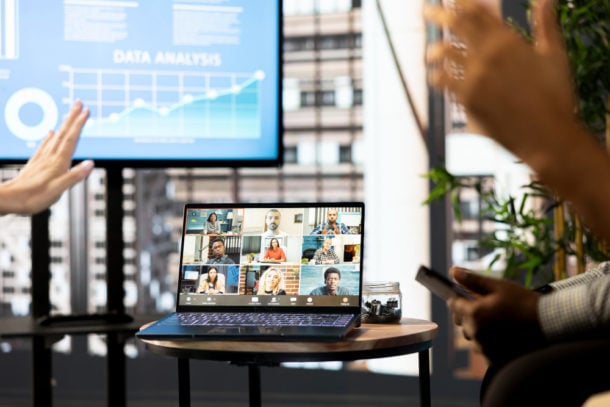
You’ve handled the basics. Your webinars run smoothly. Attendance is decent. Now let’s talk about how top-performing webinar programs separate themselves from everyone else.
Implement Engagement Scoring Models
Build systems that automatically prioritize leads. Assign point values to attendee actions: registration (+5), live attendance (+15), full completion (+20), poll participation (+5 per poll), question asked (+10), resource download (+10), CTA click (+25), post-webinar email engagement (+5 per action).
Automatically route high-scoring leads (75+ points) directly to sales. Medium scores (50-74) enter marketing qualified lead status. Low scores (<50) continue nurture campaigns. Decision-maker job titles get score boosts regardless of behavior.
Analyze Drop-Off Patterns Systematically
Use platform analytics to identify exact timestamps when people leave. Sharp drop-offs at specific moments reveal content quality issues, pacing problems, or technical glitches. Gradual decline represents normal attrition.
Remediate when you front-load key content, insert interactive elements at typical drop-off points, shorten weak sections, and test different content orders.
Conduct Cohort Analysis Across Multiple Webinars
Track attendees’ behavior over time: which topics generate strongest retention and repeat attendance, how engagement shifts from first to subsequent webinars, optimal frequency before audience fatigue, and lifetime value progression from registration to customer.
Compare cohorts by acquisition source. Direct traffic often represents highest intent. Social media attracts broader audiences that require longer nurture. Paid advertising delivers volume but may need qualification. Partner referrals typically convert at higher rates.
A/B Test Systematically, Not Randomly
Test one variable at a time with adequate sample sizes (minimum 100 registrations per variation):
- Webinar titles: “How to” vs “5 Ways” vs question format
- Timing: Tuesday 2 PM vs Wednesday 11 AM
- Duration: 30 vs 45 vs 60 minutes
- Registration form length: 2 fields vs 5 fields
- Landing page design: long-form vs short-form, video vs no video
- Email subject lines: benefit-focused vs curiosity-driven
- Presenter formats: solo vs panel vs interview
Document hypothesis before testing. Calculate statistical significance. Build a playbook of proven winners.
Leverage AI for Content Repurposing at Scale
Recent research shows dramatic increases in AI-generated content. Specifically, a 2,903% increase in AI-generated video clips between 2023-2024 demonstrates AI’s transformative impact on content multiplication.
Tools like Goldcast Content Lab, OpusClip, and Descript automatically create:
- Short social media clips (30-90 seconds) with branded captions
- Blog posts from transcripts with SEO optimization
- Email campaign content with personalization
- Quote graphics that highlight key insights
- Show notes and summaries
- Podcast episodes from audio
This multiplies your content ROI exponentially with minimal additional effort.
Build a Content Series Rather Than One-Off Events
Series-format webinars are becoming increasingly popular and can generate higher registration rates. Using “series” in titles can boost registrations significantly. Series create sustained engagement, build community, and allow deeper exploration of complex topics.
Structure series strategically: beginner to advanced progression, problem identification to solution implementation, or industry trends to specific tactics. Each session should deliver standalone value while it builds toward larger narrative.
Implement Predictive Analytics
Machine learning models can predict who will attend live vs watch replay, who will complete vs leave early, who will convert based on similar customer profiles, and optimal content length and format for specific segments.
Create Hybrid Experiences
Combine in-person and virtual attendance. Hybrid formats are seeing increased investment as they expand reach, provide flexibility, and generate multiple engagement opportunities.
Technical requirements include professional AV equipment at venues, streaming capability to virtual platforms, bidirectional audio that enables virtual attendees to be heard in-person, and unified Q&A systems that connect both audiences.
Develop Speaker Training Programs
Build internal expertise through media training for executives, presentation skills workshops, platform technical training, feedback loops through recording review, and speaker shadowing for new presenters. This improves presentation quality while it reduces external speaker costs.
Standardize Operations Through Templates
Create templates for presentation design, promotional emails, landing pages, social media posts, speaker briefings, technical checklists, and reporting. Templates enable velocity without sacrificing quality.
Focus on Accessibility Compliance
Expand your potential audience while you meet legal requirements. ADA and WCAG 2.1 Level AA standards require closed captions, screen reader compatibility, keyboard navigation, sufficient color contrast, and alternative formats.
Implementation includes automatic captions via platform features, human-edited transcripts for accuracy, descriptive alternative text for images, and keyboard shortcuts for all interactive elements. Approximately 20% of people have disabilities that could affect their ability to participate in standard webinars.
Build Integrated Technology Stacks
Connect webinar platforms with CRM, marketing automation, email platforms, analytics dashboards, project management systems, and business intelligence tools. Seamless data flow enables sophisticated automation and attribution.
The difference between good and exceptional webinar programs comes from the compounding effect of systematic optimization across every dimension rather than dramatic individual improvements.
Your Next Steps (Because Reading Without Acting Changes Nothing)

You’ve made it through this comprehensive guide on webinar planning. Now comes the hard part: actually doing something with this information.
Here’s your action plan based on where you’re starting:
If You’ve Never Run a Webinar
Don’t try to implement everything at once. Start with a simple live webinar when you follow this checklist:
- Define one clear, specific objective
- Choose a narrow, specific topic your audience cares about
- Schedule for Wednesday or Thursday at 11 AM or 2 PM in your target timezone
- Select a mid-market platform (Livestorm, Demio, or WebinarNinja)
- Create a simple landing page with clear value proposition
- Promote via email primarily, start 2 weeks out
- Conduct two full rehearsals
- Test everything 24 hours and 1 hour before
- Record the session
- Send follow-up within 24 hours
Your goal for the first webinar is completion and learning, not perfection.
If You’ve Run a Few Webinars With Disappointing Results
Diagnose what’s not working before you try new tactics:
Low registrations? Your topic isn’t compelling or your promotion is insufficient
Low attendance rate? Your reminder strategy is weak or your topic didn’t meet expectations
High drop-off? Your content isn’t delivering promised value or lacks engagement
Low conversion? Your CTA is weak or your audience targeting is off
Fix the biggest problem first. Don’t add complexity until you’ve solved fundamental issues.
If You’re Running Regular Webinars That Perform Okay
Optimize systematically:
- Implement comprehensive analytics to track all metrics mentioned in this guide
- A/B test one element at a time (start with email subject lines)
- Add AI-powered content repurposing to multiply ROI
- Build email nurture sequences for different lead scores
- Consider developing content series from your one-off events
- Create standardized templates and processes
- Set up integrated technology stack
Move from good to exceptional through marginal gains that compound over time.
If You’re Running High-Performing Webinar Programs
Focus on scale and sustainability:
- Build internal speaker development program
- Create playbooks that document best practices
- Implement predictive analytics and sophisticated segmentation
- Test hybrid event formats
- Develop strategic content series
- Build dedicated team structure
- Expand to international audiences
Your challenge becomes maintaining quality while you expand reach rather than learning fundamentals.
Commit to These Non-Negotiables
Regardless of where you’re starting:
- Always define clear objectives before planning
- Always test technical setup twice before you go live
- Always record your webinars
- Always send follow-up within 24 hours
- Always measure, analyze, and optimize
Webinar planning requires disciplined execution of proven principles rather than rocket science. Organizations seeing strong conversion rates and substantial ROI aren’t doing anything special. They’re doing the basics consistently and optimizing relentlessly.
Your next webinar can be better than your last. Your 10th can be dramatically better than your 1st. But only when you treat planning as the strategic foundation it actually is rather than the administrative checkbox it isn’t.
The webinar market reached $4.44 billion in 2025 because webinars work when done well. They generate qualified leads, educate customers, establish thought leadership, and drive revenue.
They also waste time and resources when done poorly.
Which category will your next webinar fall into? That depends entirely on how seriously you take the planning process.
Now stop reading and start planning.
Frequently Asked Questions About Webinar Planning
Get answers to the most common questions about creating successful webinars from start to finish
How far in advance should I start planning a webinar?
You should begin planning at least 6-8 weeks before your event. This allows sufficient time to define objectives, develop valuable content, prepare for technical needs, and execute a robust promotional strategy. For complex productions, such as those with multiple speakers or elaborate content, 12 weeks or more is recommended.
What are the best days and times to host a webinar?
Data shows that **Wednesday** and **Thursday** consistently have the highest attendance rates. The optimal time is typically mid-day, such as **11 AM** or **2 PM** in your target audience’s time zone. This timing avoids the frantic pace of Monday mornings and the checked-out feeling of Friday afternoons, and accommodates a wide range of U.S. time zones.
What equipment do I need for a professional webinar?
At a minimum, you’ll need a dedicated **USB microphone** (like a Blue Yeti or Shure MV7) for clear audio, a high-definition **external webcam** for better video quality, and a **ring light** or other dedicated lighting to ensure you are well-lit and professional. A wired Ethernet connection is also critical for a stable internet connection.
What’s the most effective way to promote my webinar?
Email marketing is the most powerful promotional tool. You should create a strategic email sequence that starts 2-3 weeks out and includes reminders leading up to the event. Social media and paid advertising can also be used to amplify your reach, but email consistently drives the highest number of registrations.
Should I use polls, Q&A, or other interactive features?
Yes, planned interaction is key to preventing audience drop-off. You should use polls, quizzes, and live Q&A throughout the session, not just at the end. This keeps your audience engaged and makes the experience conversational rather than a lecture.
What should I do after the webinar is over?
Within 24 hours, you need to send segmented follow-up emails to live attendees, partial attendees, and no-shows. The follow-up should include a link to the recording, a summary of key takeaways, and a clear call-to-action (CTA). You should also repurpose the content into blog posts, social media clips, and other assets to maximize your ROI.
What is a good attendance rate for a webinar?
The average attendance rate is typically **35-45%** of those who register. This means you should aim for more registrations than the number of attendees you want, as a significant portion will not attend live. Remember to also account for those who will watch the on-demand replay later, which can increase total engagement by approximately 69%.
Should I record my webinar?
Yes, absolutely. Recording your webinar is a non-negotiable step. A substantial portion of total engagement happens through on-demand viewing, and the recording is a valuable asset you can use for future lead generation, content marketing, and customer education. Always check your platform’s recording quality before the event.
What’s the difference between a good and an exceptional webinar?
Exceptional webinars are the result of disciplined, systematic optimization. They go beyond basic planning by implementing **engagement scoring models**, conducting **cohort analysis** to track attendee behavior over time, and **leveraging AI** for efficient content repurposing. They also focus on providing genuine, actionable value to the audience, and not just selling.
